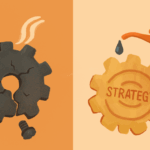This summer, TikTok announced the official rollout of its creative Commercial Content Library. In a way, it’s similar to Meta’s Ad Library Tool, in that it gives advertisers access to a library of ads published on the platform. Not only is this great for marketing intel but it also sheds light on what type of ad performs the best.
TikTok, as part of the media mix, is a compelling channel to gain incremental reach across your target audience. Although Connected TV and YouTube are in most Americans’ homes, TikTok commands nearly 95 minutes of daily average usage. Combine that with a primarily younger audience (41% of users are between 16 and 24 years old) and cost-effective CPMs, you have a great option to support any top-of-funnel efforts. It’s also a solid channel for “discoverability.” The search function is a starting point for some prospective students, and search ads are now part of the ad types media planners have to use.
When going through the pages of creative, the inventory diversity surprised me the most. There isn’t a predominant mode of creative delivery—especially as it relates to performance. This means there’s a large creative canvas from which to pull for a paid approach and the ways you may align paid and organic.
To help higher education marketers plan for the platform, I’ve pulled out four key takeaways from reviewing pages of creative across the higher education vertical.


















